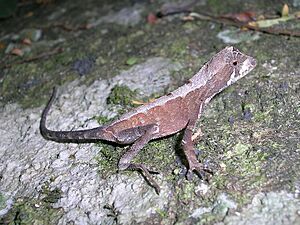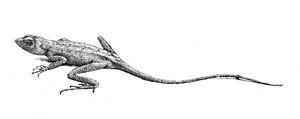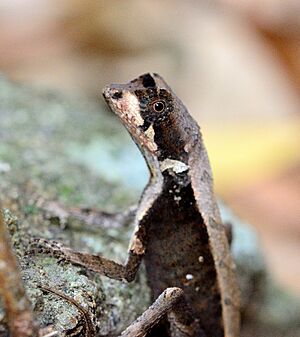Indian kangaroo lizard facts for kids
Quick facts for kids Indian kangaroo lizard |
|
|---|---|
 |
|
| Conservation status | |
| Scientific classification | |
| Genus: |
Agasthyagama
|
| Species: |
beddomii
|
The Agasthyagama beddomii, also known as the Indian kangaroo lizard, is a special type of lizard. It is active during the day (diurnal) and lives on land (terrestrial). This lizard loves to eat insects (insectivorous). It is a type of agamid lizard, which means it belongs to a family of lizards often found in warm climates. You can only find this lizard in the Western Ghats region of South India, making it endemic to that area.
Contents
What's in a Name?
The second part of its scientific name, beddomii, is a tribute to a British army officer and botanist named Richard Henry Beddome. He lived from 1830 to 1911.
Its common name, the Indian kangaroo lizard, comes from how it moves. This lizard often runs on its back legs, holding its body upright, just like a kangaroo!
Where Does It Live?
The Indian kangaroo lizard is found only in the Western Ghats mountains in India. It lives in specific areas like the Sivagiri Hills, Agasthyamalai, Cardamom Hills, and the Travancore hills. These places are located in the Tamil Nadu and Kerala states of India.
What Does It Look Like?
From its snout (nose) to its vent (where its tail starts), the Indian kangaroo lizard is about 4.5 centimeters (1.75 inches) long. Its tail is much longer, about 7.5 centimeters (3 inches) long.
Its head is covered in scales that have a sharp ridge, like a small keel, running down the middle. This feature is also seen in some lizards from Sri Lanka. The scales between its eyes are smaller and form rows.
The lizard's upper and lower lips have about 9 or 10 scales. It has small pits on each side of its neck and in front of its shoulder. The scales on its back are different sizes. The larger ones often form V-shaped patterns that point backward. The scales on its belly are larger than those on its back.
The scales on the top of its legs are large and also have keels. When its back leg is stretched along its body, its foot can reach its snout, and its heel can reach its ear opening. Its tail is round and thin, about twice as long as its head and body combined. The tail is covered with strong, keeled scales.
The lizard is usually olive-brown with dark brown patches on its back and legs. A dark slanted band runs from below its eye to its mouth. Its underside is whitish. Young lizards have a brown throat.
Where It Makes Its Home
The Indian kangaroo lizard prefers to live in moist leaf litter on the forest floor. You can find it in both evergreen forests (where trees stay green all year) and deciduous forests (where trees lose their leaves). Sometimes, it might also climb onto low tree trunks and shrubs.
Reproduction and Life Cycle
The Indian kangaroo lizard is an oviparous species. This means that the adult females lay eggs. They usually lay a clutch (group) of 3 to 5 eggs at a time.
Conservation Status
The places where the Indian kangaroo lizard lives are spread out in small patches of dense forest in the Western Ghats. These areas are south of a gap called the Shencottah Gap. This lizard seems to be very sensitive to human activities and disturbances. Because of this, its population is considered endangered.




